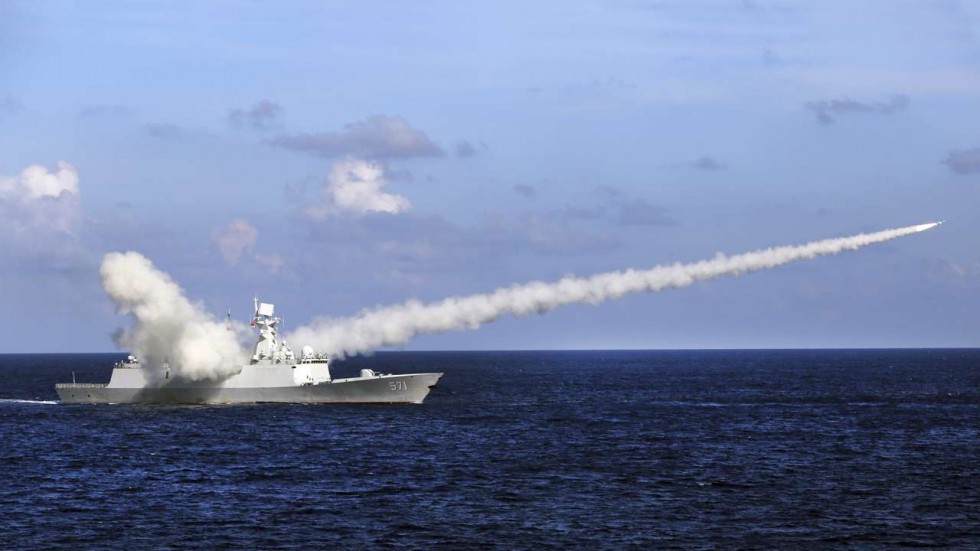The Chinese ships are no longer there for the past three days at the disputed Scarborough Shoal. There has been no announcement. The ships simply left. This could be the signpost of a new direction in China-Philippine ties following President Rodrigo Duterte’s four-day visit to Beijing on October 18.
Defence Minister Delfin Lorenzana said in Manila that it is a “welcome development” that Philippine fishermen can access the shoal unimpeded for the first time in four years. He said, “Since three days ago there are no longer Chinese ships, coast guard or navy, in the Scarborough area. If the Chinese ships have left, then it means our fishermen can resume fishing in the area.”
The carefully-worded remark hints at an understanding reached, which for some reason neither side acknowledges. The upbeat remarks by Chinese Foreign Ministry spokesman Lu Kang at a media briefing last week in Beijing on Duterte’s visit corroborates this impression. Lu said the two countries “were able to work together on issues regarding the South China Sea and appropriately resolve disputes.”
This is a startling turnaround, which catches Uncle Sam on the wrong foot. Isn’t there an old saying that success has many fathers but failure is an orphan? Washington cannot possibly claim a role in what is unfolding, since Duterte had announced his country’s ‘separation’ from the US at the Great Hall of the People in Beijing. The State Department Spokesman Mark Toner had this to say:
I think we’re still assessing. I’ve seen the comments from Manila about Chinese boats. As you said, they are no longer at the Scarborough Shoal and that Filipino fishing boats have resumed fishing in that area. So still assessing; we hope it’s certainly not a temporary measure. We’d like a see a we’d like it to be a sign that China and the Philippines are moving towards an agreement on fishing access at Scarborough reef that would be in accordance with the July 12th arbitral decision.
So, Washington picked up the news from Manila. But then, Toner also gave a spin that if China and Philippines are “moving towards” a deal, that “would be in accordance” with the decision handed down on July 12 by a tribunal at The Hague. Indeed, this was an awkward moment for Toner, because the move by Manila in 2013 to approach the Permanent Court of Arbitration itself was at American prodding, and now US is watching helplessly as Manila and Beijing sidestepped the July 12 ruling to move on to a new type of relationship.
Beijing would have multiple motives in granting Philippine fishermen conditional access to the shoal. At its core, this is a gesture to Duterte. Beijing cannot be unaware that the US might do something nasty to Duterte. There is a very vicious lobby of Manila’s political elites who do not like Duterte’s independent foreign policy course.
The military is an American clone, too. In principle, staging a coup is within US capability, but Duterte’s massive popular support, rated above 90 percent, acts as deterrent. Without doubt, Beijing also keeps an eye on the ASEAN audience. Thailand has been steadily moving out of US orbit and edging closer to China.
Vietnam just hosted three Chinese war ships on a 5-day visit to the strategically important Cam Ranh Bay naval base. Prime Minister Najib Razak’s week-long visit to China starting today may witness the signing of a contract to purchase Littoral Mission Ships (patrol boats) from China for the Malaysian Navy.
To be sure, Washington has a desperate urgency to fill the yawning gap in its alliance system in Asia. Its best hope will be that Vietnam fulfils the role. But then, Vietnam treasures its strategic autonomy. Hanoi’s single-minded objective is to transform the country as a middle income economy by 2020.
The World Bank last month commended Hanoi’s remarkable progress. Where does India fit into all this? The bottom line is that the US expects India to replace Philippines as the new linchpin of its ‘pivot’ strategy. Ambassador Richard Verma’s visit to Arunachal Pradesh can be put in perspective. A middle-ranking Japanese official also recently advised that “We are encouraging India to speak up on issues related to South China Sea…
”Fools rush in where angels fear to tread. Southeast Asia neither views India as a ‘counterweight’ to China nor shares the need to ‘contain’ China. Indian pundits went haywire exaggerating the July 12 ruling and sketching doomsday scenarios. Ironically, while a flashpoint seems increasingly unlikely in South China Sea, it is in the Himalayas that ‘hard-won’ gains under UPA government could be dissipating and tensions appearing.


